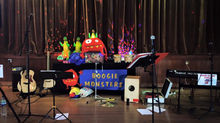Training for Motherhood
- Lucinda Newman-Jones
- Mar 28, 2016
- 3 min read

If Motherhood was an athletic event, it would be a marathon. However, there's no finish line! It's relentless and you need a strong body as well as a strong mind to cope with the physical demands of life with kids.
You have to train for the physical aspect of being a mum too and I've got some top tips to help you stay strong and fit from Bump, Birth and Beyond.
Bump
From the moment you find out you're expecting your little bundle of joy becomes a burden on your body. Don't get me wrong, it's a wonderful, wouldn’t-change-it-for-the-world, love-it-more-than-life little bundle of a burden, but a burden nonetheless. Your pelvis starts shifting, your ligaments stretch and your pelvic floor begins to weaken.

What you can do
Make sure you keep your back, core and legs strong. This will help reduce postural problems as baby grows and your centre of balance changes.
Keep up the pelvic floor exercises and adapt your core strength routine. You also want to make sure you maintain a good level of cardiovascular fitness as that can help labour and birth easier.
Birth
Postnatally, it is hugely beneficial to re-engage and gain control over your core and
pelvic floor muscles.
Lucy Blick, a physiotherapist at Bevan Wilson Physiotherapy and Sports Injuries Clinics advises to, "hold off all strenuous activity and let the body heal. Continue with your pelvic floor and deep tummy muscle activation as per during pregnancy and concentrate on good posture (neutral spine) in standing, sitting, feeding and lifting. Once you can easily co-contract your "core" muscles whilst lying supported on your back then commence activating them in sitting, standing, squatting and lifting."
What you can do
Start by practicing pelvic floor contractions (kegals) and abdominal hollowing (the action of drawing belly button up and in towards spine) as soon as you can after delivery.
At first you will feel as though you are trying and there is no response from the muscle. This is because the muscle fibres are so stretched and slack, but done daily, you will start to feel strength return to these core muscles.
Beyond
Holding and carrying a baby around for the first year produces all manner of problems for our hip and shoulder alignment - hands up if you stick your hips out to carry baby! Back pain and repetitive strain pains in wrists, shoulders and elbows are also common from the many hours spent feeding and carrying baby.

How about pushing a double buggy laden with your kids, a haul of fruit and veg, a restock of nappies and wipes, milk, the latest toy and the scooter that they swore they’d look after themselves up the high street when the wind & rain is against you? I’ve done it. Its not fun - but fitness helps.
What you can do
Good posture thanks to a strong back and core as well as having strong shoulders and arms can help hugely. Cardio, strength and weight training will help keep ALL your muscles in tip top shape.
Throwing a 20kg toddler into the air and then catching them, piggy back rides and trips to the playground are easier, safer and so much more enjoyable if you have trained with weights. Your body is better conditioned to deal with the added load.
Lucinda Newman-Jones is owner of Fitness Runs in the Family, a personal training business based in Guildford. For more of Lucy's top tips, follow Fitness Runs in the Family on Facebook.















Comments